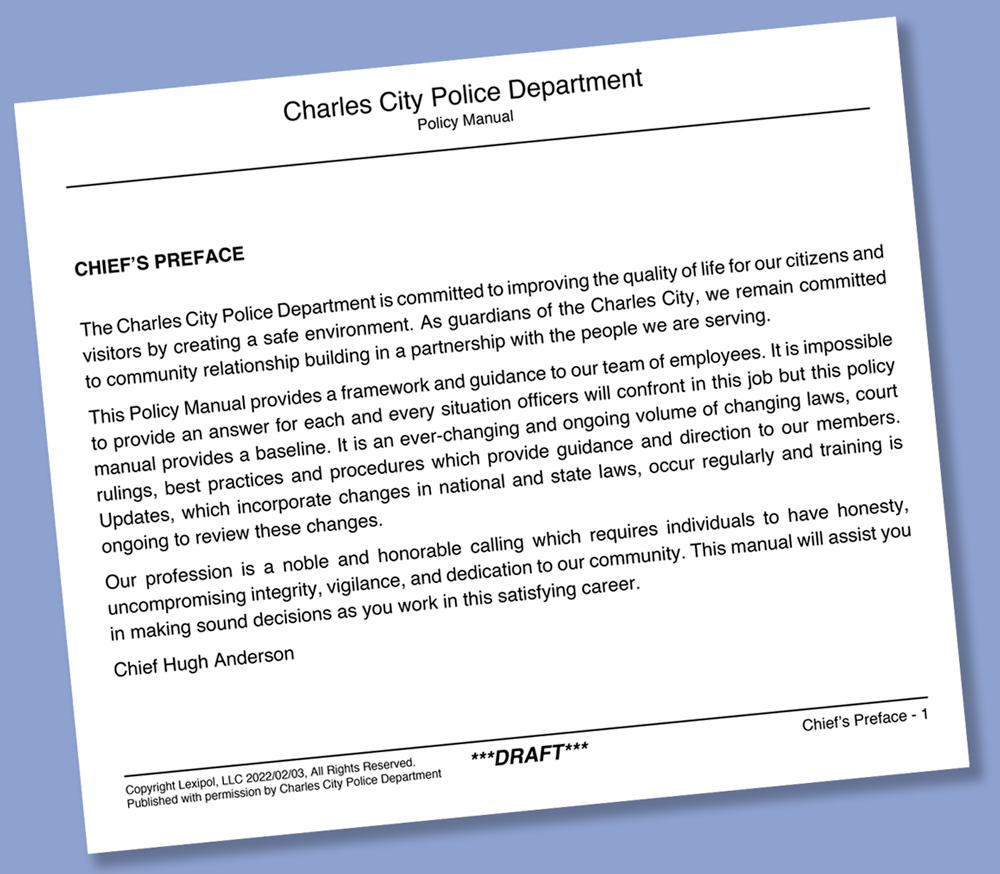Manual defines policies and procedures for Charles City Police Department
By Bob Steenson, bsteenson@charlescitypress.com
A new Charles City Police Department policy manual contains chapters that seem ripped from the headlines, covering topics such as use of deadly force, methods of restraint, pursuits, and allowing the public to record police activities.
The first half of the draft manual — five chapters that encompass 342 pages — was presented to the Charles City Council earlier this month by Police Chief Hugh Anderson and the second half was presented at Monday’s workshop meeting.
“This policy manual provides a framework and guidance to our team of employees,” Anderson said at the council meeting. “It is impossible to provide an answer for each and every situation officers will confront in this job, but this policy manual provides a baseline.”

Anderson first talked to the City Council last May about the idea of working with a national public safety policy and training company to update the department’s policies and procedures manual.
He said at the time it was partly in response to current events such as police involvement in shootings and protests around the country. When Anderson brought up the idea last May it was nearing the one-year anniversary of the death of George Floyd while in police custody in Minneapolis.
At the time of Floyd’s death, Anderson had issued a statement saying, in part, “The Charles City Police Department condemns the actions leading to the death of George Floyd at the hands of the Minneapolis Police. We as officers are expected to protect the people in our communities we serve. … We find the acts of these officers incomprehensible and deeply disturbing.”
The Charles City department worked with Lexipol, a Texas-based company, to produce the policy manual, with members of the department meeting with the company weekly.
“The entire thing is based on a national template, and then we just basically ended up going through and making it fit to our needs,” Anderson told the Press this week.
The template is designed to be able to cover much larger departments, so much of the refining was deciding what to take out, he said.
“We don’t have a jail, we don’t have helicopters, we don’t have aircraft, we don’t have transport vans. So there’s a lot of different things that are more designed for metropolitan areas that we changed,” he said.
The framework for the manual is based on national and state laws and recent court decisions, he said.
“It’s a protection for the officers, the city and the citizens,” he said. “I guess the way everything’s gone lately across the nation it’s just something that it’s the time to get it done.”
When he introduced the idea last May, Anderson said Lexipol has a “very, very large group of lawyers” that keeps reviewing practices and works to avoid situations where officers, departments or cities might get sued.
“They cover things that we as a small department wouldn’t even think of,” he said.
But Anderson also said, “I don’t want it to feel like this is something to just try to cover our butts to make sure we’re protected for a litigious situation that we might get into. I feel they’re doing it for the right reasons, also.
“To avoid the lawsuits the best way is to do the right thing, and the right thing, obviously, is to respect the individual’s rights. I feel they’re very much in line with that,” Anderson said.
One of the benefits of the $8,300 annual contract with Lexipol is that the manual is constantly kept up to date, he said.
Every day the members of his department will get a small daily training bulletin, and the bulletins and everything else in the program will be available online.
“They’ll just take that training and go through it. Eventually they’ll read through the entire manual,” Anderson said.
The manual starts off with a statement:
“The mission of the Charles City Police/Public Safety Department shall be to serve and protect the citizens of this community and all those under its jurisdiction. To preserve and enhance the quality of life in this community and surrounding areas by serving with pride, compassion, and professionalism, in a fair and unbiased manner.”
The chapter on general operations includes a wide-ranging list of items, including use of force, handcuffing and restraints, use of control devices such as batons and pepper spray, and use of Tasers.
For each item it includes a general statement of policy, when to be used, the training necessary, how using force or a control device needs to be documented, medical considerations for the person or persons on whom the force or device was used, and more.
The use of force chapter alone runs nine pages, including, “Officers shall use only that amount of force that reasonably appears necessary given the facts and circumstances perceived by the officer at the time of the event to accomplish a legitimate law enforcement purpose.”
But it also says, “While the ultimate objective of every law enforcement encounter is to avoid or minimize injury, nothing in this policy requires an officer to retreat or be exposed to possible physical injury before applying reasonable force.”
The section on factors to be used to determine the reasonableness of force has 18 points to take into consideration, and says the list includes but is not limited to:
- Immediacy and severity of the threat to officers or others.
- The conduct of the individual being confronted, as reasonably perceived by the officer at the time.
- Officer/subject factors (e.g., age, size, relative strength, skill level, injuries sustained, level of exhaustion or fatigue, the number of officers available vs. subjects).
- The effects of suspected drug or alcohol use.
- The individual’s mental state or capacity.
- The individual’s ability to understand and comply with officer commands.
- Proximity of weapons or dangerous improvised devices.
- The degree to which the individual has been effectively restrained and his/her ability to resist despite being restrained.
- The availability of other reasonable and feasible options and their possible effectiveness.
- Seriousness of the suspected offense or reason for contact with the individual.
- Training and experience of the officer.
- Potential for injury to officers, suspects, and others.
- Whether the individual appears to be resisting, attempting to evade arrest by flight, or is attacking the officer.
- The risk and reasonably foreseeable consequences of escape.
- The apparent need for immediate control of the individual or a prompt resolution of the situation.
- Whether the conduct of the individual being confronted no longer reasonably appears to pose an imminent threat to the officer or others.
- Prior contacts with the individual or awareness of any propensity for violence.
- Any other exigent circumstances.
The general operations chapter has 39 separate sections that also include officer-involved shootings, firearms, vehicle and foot pursuits, domestic abuse, search and seizure, child and adult abuse, hate crimes, standards of conduct, use of social media, media relations, death investigations, identify theft and community relations.
Under the chapter on patrol operations, in the section on recording law enforcement activity, the manual says, “The Charles City Police Department recognizes the right of persons to lawfully record members of this department who are performing their official duties. Members of this department will not prohibit or intentionally interfere with such lawful recordings.”
It says that “recordings may be made from any public place or any private property where the individual has the legal right to be present.”
But it also says, “Beyond the act of photographing or recording, individuals may not interfere with the law enforcement activity,” including tampering with a witness or suspect, inciting others to violate the law, being so close as to pose a safety hazard to the officers or interfering with the officer’s activities.
There are 10 chapters in the manual. The first five, presented to the City Council at a workshop earlier this month, are Law Enforcement Role and Authority, Organization and Administration, General Operations, Patrol Operations and Traffic Operations.
The last five, presented to the council at Monday’s meeting, are Investigation Operations, Equipment, Support Services, Custody and Personnel.
Anderson said the City Council will need to officially approve the manual.










Social Share